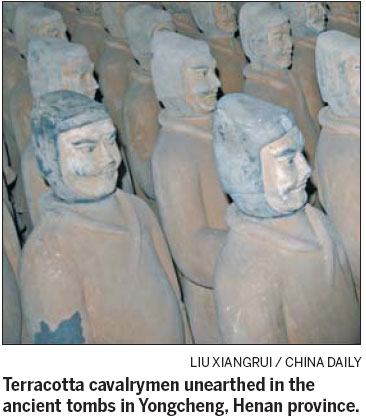
While most ancient imperial mausoleum sites draw tourists with their grand scale or extravagant treasures, the royal tombs of King Liangxiao and his wife in Mangdang Mountain of Yongcheng, Henan province, offer an added attraction.
Instead of piling up huge mounds over the burial sites, tens of thousands of workers chiseled out these tombs from the rocky hills, in effect making the hills the exterior of the mausoleum.
The mausoleums of King Liangxiao and his queen, who lived in the Western Han Dynasty (206 BC-AD 24), also amaze visitors with complex inner layouts.
One sunny day, we started our underground adventure by first visiting the queen's final resting place. Traces of hew were still visible on the ground and sidewalls at the entrance, along stacks of square stones used to seal the tomb entrance.
The queen's tomb, which was discovered in 1990, is considered to be the largest stone cave tomb found in China. It is 210 meters long and covers an area of 1,600 square meters with a volume of 6,500 cubic meters in space, all symmetrically laid out.
The site is made up of two halls connected by an axial path going from east to west, and has three side corridors and 34 lateral chambers - all these were built before the advent of gunpowder.
Visitors can easily get lost in the corridors without guides.
To prevent the mausoleum from raiders, the whole underground site was sealed and blocked with nearly 3,000 enormous stones. Each stone was also inscribed with an order number and the name of its manufacturer.
In line with the Chinese idea of "treating the dead as the living", there is also a whole set of features, such as a meeting room, bedroom, bathroom, closet, barn, weapons storehouse and toilet.
Besides offering insights into ancient people's lives, some of the facilities are also believed to be the oldest relics of their kind, including a delicately carved ice-storage chamber and stone pedestal pan.
The tomb also features a sophisticated drainage system. There is an underground passage from the queen's tomb to the king's, said to be a shortcut for the couple to meet each other in the afterworld. However, it was not completed due to the presence of spring waters.
Surprisingly, the king's mausoleum, which is next to his queen's and similar in structure, is of a smaller scale and covers 700 sq m.
The Liang State was one of the most affluent areas during its time, and the king was said to be even richer than his brother - the emperor. But King Liangxiao's ambition did not end there. His ultimate goal was the throne.
His dream was unfulfilled as he died unexpectedly of disease. The construction of his luxurious tomb, which tens of thousands of laborers already started to work when he was still young, stopped abruptly.
To maintain a lavish life in the afterworld, the king ordered all his wealth to be buried with him. But his dream ended up in vain again. This time, according to historical records, Cao Cao, a warlord who lived several hundred years later, led his huge army to raid the tomb. Cao looted tons of treasures from it. It took 72 ships to transport them.
Time and frequent tomb raids continued to wash away the past glory of the king's tomb, leaving only its stone rooms for visitors's imagination.
Delicate jade clothes, heaps of ancient coins, terracotta cavalrymen, gold-decorated chariots and many rare relics have since been unearthed in other royal tombs nearby.
One of the most precious relics consists of a 2,000-year-old giant fresco, which surprised many Chinese archaeologists when it was excavated. Painted on the ceiling of a room in the Shiyuan Tomb, the fresco of about 30 sq m, simple and fluid in style, vividly depicts an imagined heaven with Chinese mythological animals surrounded by auspicious clouds.
|
|
|
|
|
|
|
|
